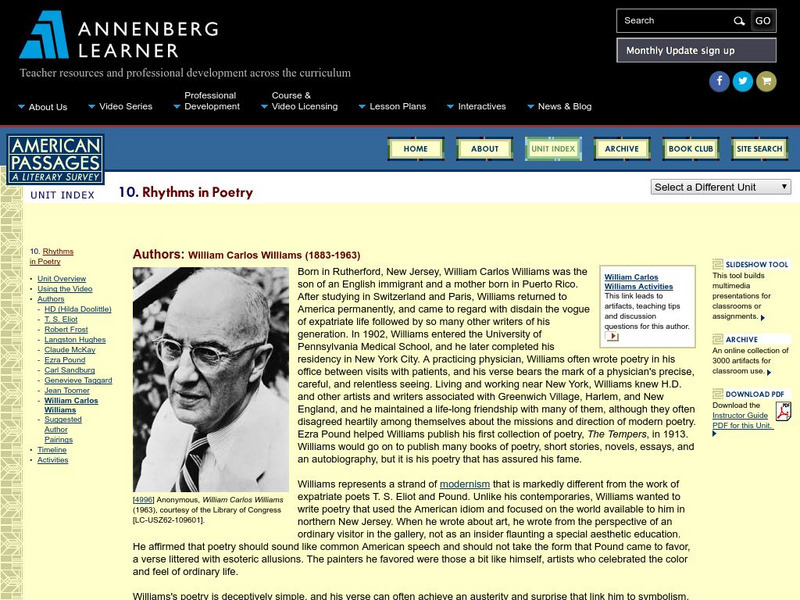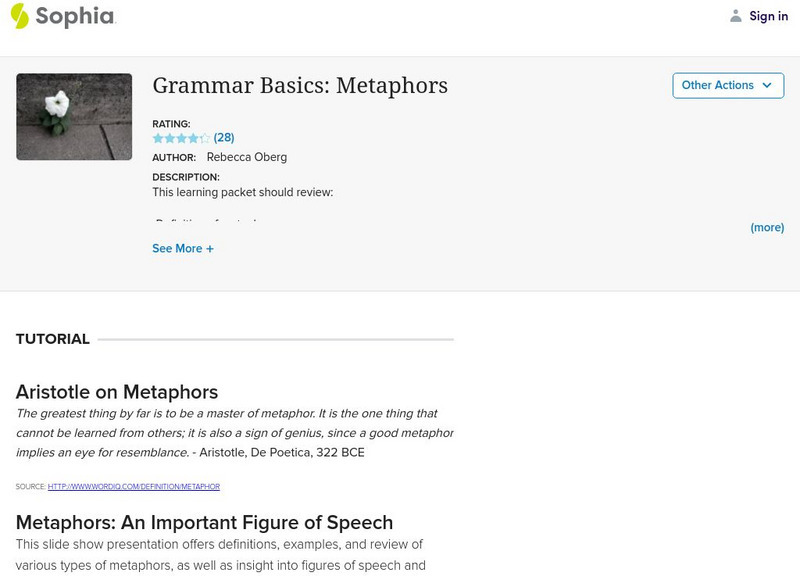Hi, what do you want to do?
Curated OER
Math in Literature and Life
Pupils read poems, read phrases, and create a poster for what math is and relate it back to literature. They also discuss the impact math has had on literature.
EngageNY
Analyzing an Author’s Craft: Carlotta’s Journey to Justice
Find your voice. Readers look at a passage from A Mighty Long Way and discuss what it means for Carlotta to find her voice. After discussing figurative language and idioms, learners listen to the song "This Little Light of Mine" and...
Curated OER
Say What?
Students explore the literal and figurative meanings of twenty-nine phrases and sayings. This unit of nine lessons integrates written expression and convention to demonstrate the value of idioms to the language.
Curated OER
Figuratively Writing...It's for the Birds!
Students identify and use literary devices such as personification, idioms, hyperbole, and metaphors. They identify one literary device and illustrate the meaning. They write a letter using correct letter format and incorporates literary...
Curated OER
Lilting Limericks
Pupils discover the formula for writing limericks and use it to write their own poems.
Curated OER
Over the River and Through the Woods:Prepositional Poetry
Fifth graders will be able to identify and use prepositions correctly in written work.¿¿¿ They will also be able to identify poetic devices.They will see how their writing can be more descriptive and "visual" for their audience.
New Vista Middle School
Hyperboles
Turn hyper bowls into hyperboles that will take away the breath of your principal and learners with the knowledge available in this presentation. The PowerPoint provides very clear and accurate information that breaks down how hyperboles...
Curated OER
Norse Mythology
Third graders read several selections of Norse mythology and compare this mythology to others studied in the past. They are introduced to runes. They read poetry and compile a class book of favorite poems. They define idioms and cite...
Curated OER
Identify Poetic Devices
In this poetic devices worksheet, students identify devices being used as alliteration, rhyme, onomatopoeia, rhyme, idiom, simile, metaphor, hyperbole or personification and explain their choice.
Curated OER
Identify Figurative Language
Your class can identify idioms, metaphosr, similes, hyperboles or personification by reading poetry and interpret meaning.
Shmoop
ELA.CCSS.ELA-Literacy.L.11-12.5
"Timid, scared, terrified." High school scholars examine words, their denotations and connotations, in a series of exercises that use lines from Shakespeare to explore figurative language and word relationships. Participants then...
Curated OER
Discovering Shoes, Step by Step
Students discuss and write about their interpretations of the art. They compare and contrast the numerous types of shoes and how they are used in a certain time and place. Students memorize the Shel Silverstein's poem, "Ickle Me, Pickle...
Curated OER
A Hodgepodge of Literature
Students complete multiple lessons to study various literature including poetry, fiction, tall tales, and phrases. In this literature lesson, students complete six lessons about poetry, fiction, and idioms.
Curated OER
Dreams
Young scholars read poetry about dreams and determine the different types of dreams people have, such as the images in sleep, or as goals.
Shmoop
ELA.CCSS.ELA-Literacy.RL.9-10.10
How do you assess what your pupils have learned over the course of the year? Find out how competent they are at reading and analyzing age-level literature with the ideas presented here. Included in this resource are two suggested...
Curated OER
The Common Core Literacy Standards - Grade 3 Posters
Brighten your third grade classroom with this series of colorful Common Core displays. Including all of the English Language Arts standards and substandards, each with supporting illustrations and examples, this resource provides clear...
Curated OER
Figurative Language: Simile and Metaphor
What is figurative language? Introduce your young learners to the most popular forms of figurative language: the simile and the metaphor. Start by reading "Willow and Ginkgo" by Eve Merriam, and identify where similes are used. Then look...
Curated OER
Vocabulary Multiple Choice Worksheet 27
In this sentence completion worksheet, students read 8 sentences that have a missing word or phrase. Students analyze the 4 similar choices and select the word that makes the sentence correct.
Curated OER
Fall Similes and Metaphors
Students interpret what a similies and metaphors are. They give examples of similies and metaphors. Pupils write different similies and metaphors using fall or autumn descriptive words. Students base their comparisons on facts, once they...
Georgia Department of Education
Ga Virtual Learning: Contemporary Literature: The Modern Poet: Poetry Terms
This is a poetry terms presentation which defines poetry terms.
Annenberg Foundation
Annenberg Learner: American Passages: Rhythms in Poetry: William Carlos William
This biography highlights author William Carlos Williams' contributions to American literature with emphasis on ordinary life and everyday language, particularly in his poetry. See "William Carlos Williams Activities" for related materials.
Sophia Learning
Sophia: Grammar Basics: Metaphors
Learn about similes and metaphors through this multimedia presentation. First view a slide show describing different types of metaphors as well as a simile. Then watch a video [3:13] showing similes and metaphors used in popular songs. A...
Other
Allan Ginsberg: Part I of Howl
This site contains the text to only part I of the poem HOWL, by Allan Ginsberg.



























